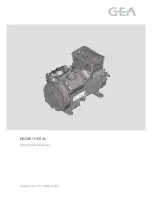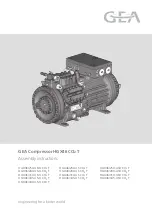
16
C950 PLANNING & INSTALLATION MANUAL
TP0029 Rev5
Ó
2000 Ingersoll-Rand Company
Date of Revision: 15 August, 2000
Figure 7
Centrifugal and Positive Displacement Piping Arrangement
Receivers
Receivers store compressed air for systems in which air demand fluctuates over a short
period of time. A properly sized receiver will decrease the number of times the compressor
loads and unloads. This will increase the compressor's efficiency and decrease wear on
valve components. Receivers can be installed as "Wet" (before the dryer) or "Dry" (after the
dryer) receivers or in both locations. Contact your local Ingersoll-Rand representative for
assistance in properly sizing and locating this equipment.
A receiver may also be used to isolate centrifugal compressors (or other equipment) from
pulsations created by positive displacement air compressors. A pulsation bottle may be
needed to eliminate pulsations more effectively.
Control Air Piping
The control air pipe penetration is made at a minimum of 10 pipe diameters downstream of
the discharge check valve in the discharge pipe (
see Figure 6
). The control air line connects
to the control panel bulkhead fitting marked ‘CA’
(see Figure 8)
, which is a 1/2 inch NPT
connection. The control air line should be a minimum of 1/2 inch diameter, made of a non-
rusting material such as stainless steel, aluminum, or copper. If the line is to be installed in a
horizontal run of pipe, it should be located at the top of the discharge pipe to minimize
condensate or debris buildup in the line. The control air line should be routed to the control
panel in such a manner that the line will not have to be disconnected in order to perform
major maintenance. A drip leg with a drain valve, which can be used to remove condensate,
is recommended as part of the customer’s control air line.
Centac
Recips or
Screws
Centac
Centac
Centac
Centac
Centac
Recips or
Screws
Receiver
Flow
System Header
Long radius elbow
Angle with flow
Flow
01_
24 of 41
90.10_Pre-Installation and Operation Manual
















































